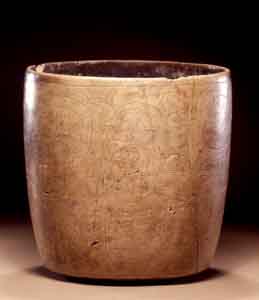Mayavase.com Research Material


Click here for a large drawing
The drawing above and comments below are derived from The Blood of Kings
by Linda Schele and Mary Miller, p. 308
Mayavase.com Research Material


Click here for a large drawing
The drawing above and comments below are derived from The Blood of Kings
by Linda Schele and Mary Miller, p. 308
This cylinder is finely incised with a complex cosmic scene that was cut into the clay at the leatherhard stage, and highlighted by a subtle tonal contrast between the positive shapes and the background field. This image was never designed to
be read, especially from any distance, since it is too complex to understand in a single viewing. Neither was it intended to be narrative or instructive; rather, the image functions to transform an ordinary container into an object that focuses power through ritual. It is addressed not to a human user, but to the gods called forth in ritual.
This extraordinary image begins with a stepped portal that terminates on both sides with a personified akbal "darkness" glyph. It represents both an architectural opening and the forehead depression of the Cauac Monster; it is the cave entrance to Xibalba, and the Maw of the Underworld. On the upper left step grows a tree, certainly the World Tree at the center of the universe. Three anthropomorphic beings climb up it into our World. We are not sure of their identities, but their Roman noses, square eyes, and body forms put them within the complex of gods that includes GI, GIII, the Sun God and the Headband Twins, whom they may represent as generic types. Since the Twins are usually represented in pairs, the presence of three climbers may refer to the gods of the Palenque Triad.
The front head of the Celestial Monster, complete with forearm but lacking his deer ear, is climbing onto the bottom step. His mouth gapes open to spit out a huge Vision Serpent. The Serpent undulates outward, its body looping back on itself four times, entirely encircling the vase. Stopping just behind the World Tree, it belches out its vision in the form of a squarenosed dragon. The body of the Serpent is marked with jade disks, mirror signs and personification heads. A personification wing is attached to its eyebrow; an akbal sign is inscribed on its cheek; and a bird emerges from the corner of its mouth, as on the Acasacuastlan Vase (K2776). The three loops of the feathered body contain god heads: two appear to be personification heads and the third is a long lipped zoomorph with death collar and akbal glyph. Most interestingly, the Serpent's beard is personified as though to emphasize that the Vision Serpent is an icon of power.
Sandwiched between two of the body loops is a moon sign. Inside sits the Moon Goddess holding a rabbit, the one the Maya saw in the dark areas of the moon. Under and behind the head of the Vision Serpent is a deer-eared anthropomorph who bends under the looping trajectory of the Serpent as it surges out of the Underworld. His back is marked with a mirror sign and a feather fan runs from shoulders to rump. He wears a trilobed shell pectoral and blows mightily on a conch shell to announce the arrival of the Vision Serpent.
